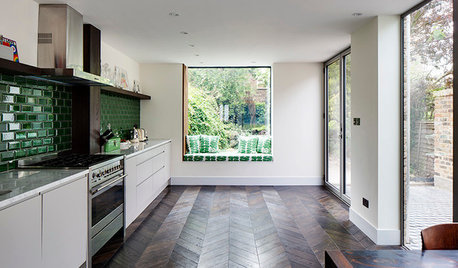filling before staining?
bluesbarby
18 years ago
Related Stories

HOUSEKEEPINGDon't Touch Another Stain Before You Read This
Even an innocent swipe with water may cause permanent damage. Here's what to know about how rugs and fabrics react
Full Story
HOUZZ TOURS13 Character-Filled Homes Between 1,000 and 1,500 Square Feet
See how homeowners have channeled their creativity into homes that are bright, inviting and one of a kind
Full Story
ECLECTIC HOMESMy Houzz: Color and Texture Fill an Eclectic Pittsburgh Row House
Moroccan touches join exposed brick, salvaged materials and scads of books in this home for a creative couple
Full Story
ADDITIONSLight and Personality Fill a Remodeled London Home
Eclectic and heritage elements mix in a clever extension that adds volume without digging into the home’s foundation
Full Story
HOUZZ TOURSHouzz Tour: A New Layout Opens an Art-Filled Ranch House
Extensive renovations give a closed-off Texas home pleasing flow, higher ceilings and new sources of natural light
Full Story
ADDITIONSRoom of the Day: A Light-Filled Loft-Style Kitchen Addition
A period London property embraces industrial style and exposed materials with an open-plan layout
Full Story
HOUZZ TOURSMy Houzz: A Stylish Brooklyn Apartment Filled With Memories
Collected pieces from travels, family heirlooms and contemporary finds turn an apartment into a home for 3
Full Story
GREAT HOME PROJECTSWhat to Know Before Refinishing Your Floors
Learn costs and other important details about renewing a hardwood floor — and the one mistake you should avoid
Full Story
DECORATING GUIDESWhat You Need to Know Before Painting Brick
Sure, painted brick can be a great look. But you need to take some risks into account. Here's how to paint brick like a pro
Full Story
REMODELING GUIDESA Dark Atlanta Attic Welcomes a Light-Filled Bathroom
From architecturally quirky attic to sunny bathroom, this renovated space now has everything a growing family could need
Full Story







brickeyee
cindyandmocha
Related Professionals
Indian Creek Cabinets & Cabinetry · Norfolk Carpenters · Sandusky Carpenters · Cedar Park Flooring Contractors · Cleveland Flooring Contractors · Hammond Flooring Contractors · Kendall West Flooring Contractors · Monroe Flooring Contractors · Patterson Flooring Contractors · Sachse Flooring Contractors · Scottsboro Flooring Contractors · The Crossings Flooring Contractors · San Elizario Furniture & Accessories · Adelanto Furniture & Accessories · Vail Furniture & AccessoriesbluesbarbyOriginal Author
brickeyee
FatHen
User
brickeyee
User
User
User
sombreuil_mongrel
FatHen
brickeyee
kyler_grow